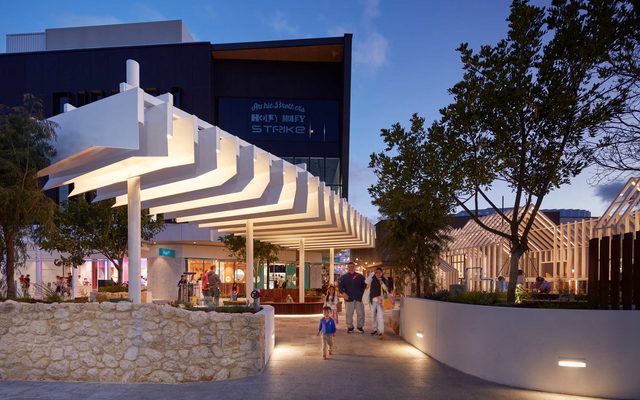This article is from the Australian Property Journal archive
MYER is struggling to keep up with the changing Australian retail conditions, forced to revise its sales targets and metrics for the coming years. At the same time, a survey reveals Myer and David Jones will be threatened by the arrival of Amazon.
Recently flagged store closures were reaffirmed and may tally as many as 19, and a new report showed commercial property investors consider Myer and fellow department store major David Jones to be most at risk of the US retail behemoth’s introduction.
Sales for the Myer were down 2.8% over the quarter to $699.0 million, and sales on a comparable store sales basis fell by 2.1%.The shedding of stores saw an uptick in sales per sqm of 3.6%.
Myer CEO Richard Umbers, said the figures “reflect the continuation of challenging retail conditions characterised by heightened competition and subdued consumer sentiment”.
Perhaps instructively, its online business posted growth of 67.8%, with omni-channel sales totalling $48.4 million and click & collect were up 22.1% or orders.
At its strategy day, Umbers also revealed that the group had shifted its metrics launched alongside its “New Myer” program in 2015.
Sales were initially aimed to return sales growth of greater than 3% between 2016-2020; sales per sqm of greater than 20% improvement by 2020, EBITDA growth ahead of sales growth by 2017; and ROFE greater than 15% by 2020.
Caught surprised by the deterioration of the retail sector, those four key planks have replaced with the sales productivity aim of improvement in sales greater than 10% per sqm from FY17-20; improvement in cost of doing business productivity to sales of at least 50 basis points by FY20; underlying earnings per security improvement of least 5% compound annual growth rate over FY17-20; and return on capital of greater than 10% by 2020.
“The financial metrics we established at the start of the journey were developed during a period of relative buoyancy and were appropriate for the retail environment at that time,” Umbers said.
“We have recalibrated our Metrics to reflect the tougher trading conditions and also to incorporate the evolution of the strategy into the future.”
Umbers noted that customers are “increasingly shopping online, and traffic to shopping centres and physical stores is declining,”. The company stopped short of naming which stores would be closing.
“All of Myer’s metrics in digital and online are moving strongly in the right direction. Sales, profitability, click and collect take up, website traffic and conversion are all increasing. Cost of fulfilment, and fulfilment times are falling.” Umbers said.
Its strong online and omni-channel numbers followed online sales growth of 41% in FY17, which saw “omni-customers” – those who shop online and in-store – grow by 13%. Its omni-channel strategy focuses on selecting online orders from physical stores.
Myer is also planning the launch its Myer Market online platform as a combatant to the Amazon Marketplace, which will offer a range of items and brands via an online site distinct to its current home site.
Meanwhile, the Australian Market Expectations Survey by Urban Property Australia and Situs RERC showed 41% of the 276 respondents, which includes landlords, fund managers, valuers, investment bankers, private investors, real estate agents, REIT analysts and others, believed that Myer and David Jones would be impacted most by Amazon.
This was followed by Harvey Norman and The Good Guys, then JB Hi-Fi, and a smaller amount nominated discount department stores Target, Big W and Kmart.
“For landlords, it shows the shopping centre is not static, and remixing must be an ongoing and central strategy for a shopping centre to maintain its relevance,” UPA’s managing director, Sam Tamblyn said.
“Amazon will simply be another factor pushing property owners to remix with secondary centres, the most vulnerable to the impact of online retail,” he added.
The report said the rise in e-commerce means an upsurge in the demand for industrial assets, and a dwindling demand for retail space.
“Australia’s brick-and-mortar retailers can expect increased pressure to compete and will be forced into making their businesses an experience rather just a place to shop,” Tamblyn said.
The survey also indicated that Amazon is likely to have the biggest impact on the bulky goods, high street retail and outlet centre sectors, while CBD retail and shopping centres are considered best-placed to handle its presence.
“Amazon is not just a juggernaut in the retail industry; it is a disruptor. It is not just that Amazon allows people to shop from the convenience of their own homes; in the US, Amazon has transformed the way people think about and interact with retailers.” Tamblyn said.
Earlier this week Macquarie Group published a report of shopping centre landlords exposed to more store closures, reflecting the trends in the United States, in the face of subdued consumer spending, flat wages growth, online retailing and Amazon.
In the US, Sears said last month it was closing 43 stores – on top of the 265 it announced earlier this year. JCPenney released a list of 138 stores it will close in 2017 and Macy’s said it would close 100 stores.
In the last five years, department stores have reduced their footprint by 24% and sales have fallen from 14.3% of retail sales to 6.1%.
Macquarie revealed that Vicinity Centres and Scentre Group have the largest exposure to the major retailers. Vicinity Centres has 67 discount department stores and 15 department stores in its portfolio, including 29 Kmart, 19 Target, 19 Big W, 10 Myer and five David Jones. Scentre Group has 74 DDS and 38 DS, including 24 Kmart, 32 Target, 18 Big W, 22 Myer and 16 David Jones.
Myer’s results shone a brighter spotlight on concerns that its major shareholder Solomon Lew, who holds a 10.8% stake in the group via Premier Investments, has voiced through numerous public critiques in recent months.
That stake was acquired for $101 million at $1.14 per share in March, and Myer’s share price hitting as low as $0.73 per share yesterday.
Lew has been seeking board representation and repeatedly challenged incoming chairman Garry Hounsell, who is expected to continue the New Myer strategy.
Myer will be looking to speed up the introduction of “six new food partners, five upgraded food offers and 12 locations for new beauty and grooming services.”
It will also seek to utilise customer data and its Myer One program to personalise offerings.
Australian Property Journal




